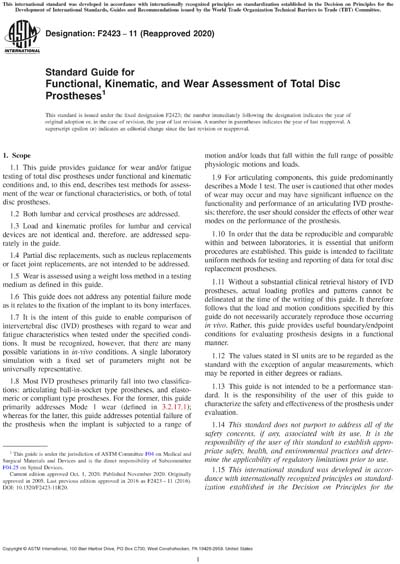Most recent
ASTM F2423-11(2020)
Standard Guide for Functional, Kinematic, and Wear Assessment of Total Disc Prostheses
1.1 This guide provides guidance for wear and/or fatigue testing of total disc prostheses under functional and kinematic conditions and, to this end, describes test methods for assessment of the wear or functional characteristics, or both, of total disc prostheses.
1.2 Both lumbar and cervical prostheses are addressed.
1.3 Load and kinematic profiles for lumbar and cervical devices are not identical and, therefore, are addressed separately in the guide.
1.4 Partial disc replacements, such as nucleus replacements or facet joint replacements, are not intended to be addressed.
1.5 Wear is assessed using a weight loss method in a testing medium as defined in this guide.
1.6 This guide does not address any potential failure mode as it relates to the fixation of the implant to its bony interfaces.
1.7 It is the intent of this guide to enable comparison of intervertebral disc (IVD) prostheses with regard to wear and fatigue characteristics when tested under the specified conditions. It must be recognized, however, that there are many possible variations in in-vivo conditions. A single laboratory simulation with a fixed set of parameters might not be universally representative.
1.8 Most IVD prostheses primarily fall into two classifications: articulating ball-in-socket type prostheses, and elastomeric or compliant type prostheses. For the former, this guide primarily addresses Mode 1 wear (defined in 3.2.17.1); whereas for the latter, this guide addresses potential failure of the prosthesis when the implant is subjected to a range of motion and/or loads that fall within the full range of possible physiologic motions and loads.
1.9 For articulating components, this guide predominantly describes a Mode 1 test. The user is cautioned that other modes of wear may occur and may have significant influence on the functionality and performance of an articulating IVD prosthesis; therefore, the user should consider the effects of other wear modes on the performance of the prosthesis.
1.10 In order that the data be reproducible and comparable within and between laboratories, it is essential that uniform procedures are established. This guide is intended to facilitate uniform methods for testing and reporting of data for total disc replacement prostheses.
1.11 Without a substantial clinical retrieval history of IVD prostheses, actual loading profiles and patterns cannot be delineated at the time of the writing of this guide. It therefore follows that the load and motion conditions specified by this guide do not necessarily accurately reproduce those occurring in vivo. Rather, this guide provides useful boundary/endpoint conditions for evaluating prosthesis designs in a functional manner.
1.12 The values stated in SI units are to be regarded as the standard with the exception of angular measurements, which may be reported in either degrees or radians.
1.13 This guide is not intended to be a performance standard. It is the responsibility of the user of this guide to characterize the safety and effectiveness of the prosthesis under evaluation.
1.14 This standard does not purport to address all of the safety concerns, if any, associated with its use. It is the responsibility of the user of this standard to establish appropriate safety, health, and environmental practices and determine the applicability of regulatory limitations prior to use.
1.15 This international standard was developed in accordance with internationally recognized principles on standardization established in the Decision on Principles for the Development of International Standards, Guides and Recommendations issued by the World Trade Organization Technical Barriers to Trade (TBT) Committee.
Content Provider
ASTM International [astm]






